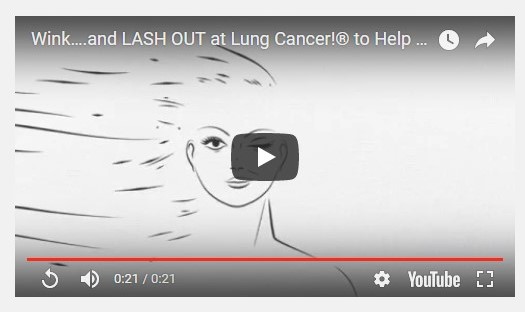To participate, post a photo on social media winking and lashing out at lung cancer. Use the hashtag #WinkandLashOut.

The Lung Cancer Research Foundation launched the Wink….and LASH OUT at Lung Cancer!® campaign to help support lung cancer awareness in women. To participate, post a photo on social media winking and lashing out at lung cancer. Use the hashtag #WinkandLashOut.
The campaign, launched in November 2017, continues.
The Facts: Women and Lung Cancer
- Lung cancer is the number one cancer killer in women.
- Lung cancer kills more women than breast, ovarian and cervical cancers combined.
- Worldwide, over 400,000 women die of lung cancer each year.
- While lung cancer diagnoses have been steadily decreasing for men, they appear to be leveling off for women in recent years.
- Lung adenocarcinoma is the most common type of lung cancer found in women and men in the US.
- Lung cancer has overtaken breast cancer as the leading cancer killer of women in developed countries, reflecting changing smoking patterns.
- While smoking represents the number one risk factor for developing lung cancer, up to 20 percent of women who are diagnosed with lung cancer may have never touched a cigarette.
- Non-smokers who develop lung cancer are more likely to be women than men.
- In 2018, an estimated 70,000 women will die of lung cancer in the US.
- Lung cancer in women who have never smoked tends to occur in younger women and Asian women.
About the Wink….and LASH OUT at Lung Cancer®! campaign
- Read the campaign press release
- Share your photos! Using the hashtag #WinkandLashOut, post a photo winking and lashing out at lung cancer to help raise awareness about women and lung cancer. Your photo may be featured on the Lung Cancer Research Foundation’s website, social media channels and in promotional materials.

See the YouTube video here: https://youtu.be/3vzienmt6jw
The Lung Cancer Research Foundation’s women and lung cancer campaign has been supported in part by:
Anonymous; Astellas; Dianne Barker; Bristol-Myers Squibb; Leonor Coello; M. Carol Gardner; Dina Garland; Genentech; Missy Gothard; Christina Guthman; Katasha Harley; Lauren Hulkiwer; Jeweled Kisses by Jade; Kimberly Kravis; Amalia Dayan Lindemann; Adam Lindemann; Delia Naughton; Jennifer Mormile; Paragon Management Associates, Inc.; Nancy Sanford; Patricia Smith
Sources:
American Cancer Society. Cancer Facts & Figures 2018. American Cancer Society Website. https://www.cancer.org. Accessed March 2018.
Howlader N, Noone AM, Krapcho M, et al, eds. SEER Cancer Statistics Review, 1975-2014. Bethesda, MD: National Cancer Institute; US Dept of Health and Human Services; 2017.
Kovalchik SA, De Matteis S, Landi MT, et al. A regression model for risk difference estimation in population-based case–control studies clarifies gender differences in lung cancer risk of smokers and never smokers. BMC Med Res Methodol. 2013;13:143.
PDQ Adult Treatment Editorial Board. Non-Small Cell Lung Cancer Treatment (PDQ®): Health Professional Version. Bethesda, MD: National Cancer Institute; US Dept of Health and Human Services; 2017.
Stewart BW, Wild CP, eds. World Cancer Report 2014. Lyon, France: International Agency for Research on Cancer, World Health Organization; 2014.
Sun S, Schiller JH, Gazdar AF. Lung cancer in never smokers – a different disease. Nat Rev Cancer.2007;7(10):778–790.
Tam IY, Chung LP, Suen WS, et al. Distinct epidermal growth factor receptor and KRAS mutation patterns in non-small cell lung cancer patients with different tobacco exposure and clinicopathologic features. Clin Cancer Res. 2006;12(5):1647–1653.
Zang EA, Wynder EL. Differences in lung cancer risk between men and women: examination of the evidence. J Natl Cancer Inst. 1996(3-4);88:183–192.


